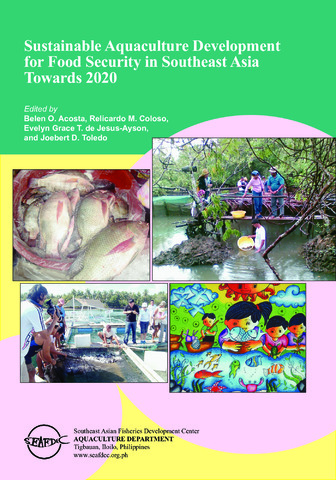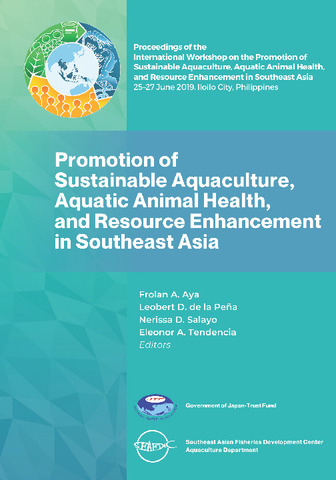| dc.description.abstract | Aquaculture plays a predominant role in the Philippines, an archipelago of 7,150 islands with 36,300 km of coastline, 26.6 million ha of coastal waters, and 250,000 ha of lakes, rivers and reservoirs over which are spread 239,000 ha of brackish-water ponds and 14,500 ha of freshwater ponds. From a mere 25,500 mt valued at P33.1 million in 1950, aquaculture production has increased to 38.2 million mt valued at P35.4 billion in 2002, and employs some 258,500 persons. Aquaculture contribution to total fisheries’ production in the 1950-2002 period has similarly increased from 11.6 % to 38.2 % by volume, and from 15.4 % to 31.3 % by value. Next to yields of 894,858 mt of seaweeds and bivalves from mariculture, Philippine aquaculture was dominated in 2002 by brackish-water pond production of 246,937 mt, followed by 94,697 mt from marine and freshwater pens/cages and 70,425 mt from freshwater ponds.
Notwithstanding its major contribution to the Philippine economy, aquaculture development has come with many environmental and social costs. Foremost among these is mangrove conversion to culture ponds, mainly for milkfish — around half of the 279,000 ha of mangroves lost from 1951 to 1988 were developed into culture ponds. Ninety-five percent of Philippine brackish-water ponds in 1952-1987 were derived from mangroves. Mangroves have contributed significantly to the well-being of coastal communities for centuries through products used for fuel, construction, fishing, agriculture, forage, and food items mainly fish, crustaceans and mollusks. Mangroves also provide a variety of ecosystem services such as coastal protection provided by a buffer zone during typhoons and storm surges, reduction of shoreline and riverbank erosion, stabilizing sediments, control of flooding and recycling of nutrients.
Other environmental impacts are pollution of lake and coastal waters from intensive pond, pen and cage culture; dependence on fish meal and fish oil for feeds; use of chemicals and antibiotics; spread of parasites and diseases; excessive harvesting of wild seed and adults and loss of bycatch. Socioeconomic consequences have the greatest effect on rural communities — loss of mangrove goods and services, blocked access to coastal resources, navigational hazards, privatization of lands and waterways, fishery decline, food insecurity, rural unemployment and urban migration, social disruption and conflicts.
The future sustainability of Philippine aquaculture depends not only on farm level practices but also on the integrated management of the coastal zone and government action to prevent or redress environmental and socioeconomic damage. Pond, pen and cage systems for growout need to reduce and mitigate negative impacts and become more environmentally responsible through the development and/or wider dissemination of available onfarm technologies. These cover water management (closed/semiclosed cycles with low to zero water exchange, reservoir/treatment-settling ponds, greenwater techniques), feed management (reduced fishmeal/fish oil levels, lower N, P in effluents), effluent management (biofilters using seaweed, oysters and external filters such as mangroves, sludge processing and disposal, fallowing), and reduced use of antibiotics and chemicals. Aquaculture needs greater integration, e.g. the polyculture of more than one species in the same pond, or aquasilviculture where fish/shrimp/crab culture is integrated with mangroves.
Only one among the many uses of the coastal zone, aquaculture should develop within the framework of Integrated Coastal Zone Management (ICZM). For example, siting of aquaculture farms should be based on the ecological footprint of the farming technology, and farm density should not exceed environmental capacity of a given area. ICZM features coastal zonation based on carrying or assimilative capacity of the environment; valuation of alternative resource uses; buffer zones between aquafarms and villages, rice paddies, rehabilitation of mangroves and other degraded habitats; participation of various stakeholders, e.g. fishers, aquafarmers; protection of communal resources, rights and access of marginalized groups; and mechanisms for conflict resolution. The government should enforce existing laws; institute a clear national aquaculture policy with corresponding institutional arrangements such as resource use fees for land, groundwater use, and penalties to fund environmental rehabilitation and compensate socioeconomic damage and become mangrovefriendly by adopting silvofisheries (or aquasilviculture where crabs/fish/shrimp are reared at low density in mangrove ponds and pens) or integrating mangroves filter adjacent to intensive fish/shrimp ponds. All these require a paradigm shift from the short-sighted common exploitation of water, mangroves and other resources to the ecological footprint approach incorporating not only inputs such as feed and seed, but also outputs, e.g. effluent treatment facilities. | en |



